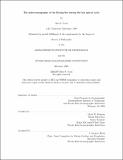| dc.contributor.advisor | Lloyd D. Keigwin. | en_US |
| dc.contributor.author | Cook, Mea S. (Mea Young Sohn) | en_US |
| dc.contributor.other | Woods Hole Oceanographic Institution. | en_US |
| dc.coverage.spatial | pn----- | en_US |
| dc.date.accessioned | 2006-10-31T15:22:54Z | |
| dc.date.available | 2006-10-31T15:22:54Z | |
| dc.date.copyright | 2006 | en_US |
| dc.date.issued | 2006 | en_US |
| dc.identifier.uri | http://hdl.handle.net/1721.1/34271 | |
| dc.description | Thesis (Ph. D.)--Joint Program in Oceanography (Massachusetts Institute of Technology, Dept. of Earth, Atmospheric, and Planetary Sciences; and the Woods Hole Oceanographic Institution), 2006. | en_US |
| dc.description | This electronic version was submitted by the student author. The certified thesis is available in the Institute Archives and Special Collections. | en_US |
| dc.description | Includes bibliographical references (leaves 117-126). | en_US |
| dc.description.abstract | In this thesis, I present high-resolution stable-isotope and planktonic-fauna records from Bering Sea sediment cores, spanning the time period from 50,000 years ago to the present. During Marine Isotope Stage 3 (MIS3) at 30-20 ky BP (kiloyears before present) in a core from 1467m water depth near Umnak Plateau, there were episodic occurrences of diagenetic carbonate minerals with very low 13C (-22.4%), high 18O (6.5%), and high [Mg]/[Ca], which seem associated with sulfate reduction of organic matter and possibly anaerobic oxidation of methane. The episodes lasted less than 1000 years and were spaced about 1000 years apart. During MIS3 at 55-20 ky BP in a core from 2209m water depth on Bowers Ridge, N. pachyderma (s.) and Uvigerina 18O and 13C show no coherent variability on millennial time scales. Bering Sea sediments are dysoxic or laminated during the deglaciation. A high sedimentationrate core (200 cm/ky) from 1132m on the Bering Slope is laminated during the Blling warm phase, Allerd warm phase, and early Holocene, where the ages of lithological transitions agree with the ages of those climate events in Greenland (GISP2) to well within the uncertainty of the age models. The subsurface distribution of radiocarbon was estimated from a compilation of published and unpublished North Pacic benthic-planktonic 14C measurements (475{2700 m water depth). There was no consistent change in 14C probles between the present and the Last Glacial Maximum, Blling-Allerd, or the Younger Dryas cold phase. N. pachyderma (s.) 18O in the Bering Slope core decreases rapidly (in less than 220 y) by 0.7-0.8h at the onset of the Blling and the end of the Younger Dryas. These isotopic shifts are accompanied by transient decreases in the relative abundance of N. pachyderma (s.), suggesting that the isotopic events are transient warnings and sustained freshenings. | en_US |
| dc.description.statementofresponsibility | by Mea S. Cook. | en_US |
| dc.format.extent | 126 leaves | en_US |
| dc.format.extent | 2473371 bytes | |
| dc.format.extent | 2917697 bytes | |
| dc.format.mimetype | application/pdf | |
| dc.format.mimetype | application/pdf | |
| dc.language.iso | eng | en_US |
| dc.publisher | Massachusetts Institute of Technology | en_US |
| dc.rights | M.I.T. theses are protected by copyright. They may be viewed from this source for any purpose, but reproduction or distribution in any format is prohibited without written permission. See provided URL for inquiries about permission. | en_US |
| dc.rights.uri | http://dspace.mit.edu/handle/1721.1/7582 | |
| dc.subject | Joint Program in Oceanography. | en_US |
| dc.subject | Earth, Atmospheric, and Planetary Sciences. | en_US |
| dc.subject | Woods Hole Oceanographic Institution. | en_US |
| dc.subject.lcsh | Paleoceanography Bering Sea | en_US |
| dc.subject.lcsh | Marine sediments | en_US |
| dc.title | The paleoceanography of the Bering Sea during the last glacial cycle | en_US |
| dc.type | Thesis | en_US |
| dc.description.degree | Ph.D. | en_US |
| dc.contributor.department | Joint Program in Oceanography | en_US |
| dc.contributor.department | Woods Hole Oceanographic Institution | en_US |
| dc.contributor.department | Massachusetts Institute of Technology. Department of Ocean Engineering | |
| dc.identifier.oclc | 71196768 | en_US |
